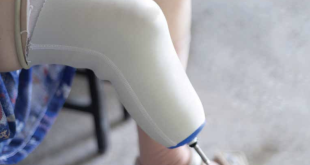Words by Dr Niran Maharjan
“In Meleney’s Gangrene, misdiagnosis as cellulitis is common, leading to delayed and insufficient treatment, exacerbating the condition.”
The potentially deadly bacterial infection commonly known as necrotizing fasciitis or progressive necrotizing infection of the abdominal wall was first described in 1926 by New York surgeons Dr. Brewer and Dr. Meleney. This rare entity often occurs in the post-surgical abdominal wounds but even can occur as a sequel of scratching and insect bites. With the entry of the bacteria (commonly, hemolytic Staphylococcus aureus and non-hemolytic Streptococcus), there is initial phase of infection of the underlying subcutaneous tissue and fascia which leads to the occlusion of the small blood vessels thus causing the necrosis of the overlying skin.
(Box presentation)
Four types of Necrotizing fasciitis
The type I is polymicrobial meaning there is more than one group of bacteria involved.
The type II is caused by hemolytic group A streptococcus and/or staphylococci.
The type III is due to the gas forming species like clostridium.
The type IV is caused either by the marine organisms like vibrio and aeromonas hydrophila (some consider this as Type III) or fungal infection like candida and zygomycetes.
The risk factors for this infection are immunocompromised state like diabetes mellitus, person taking immunosuppressive drugs or having severe chronic illness, advanced age, obesity, malignancy, advanced age, drug abuse and post-operative status. But even in a healthy person this condition can occur if the breach in the skin occurs in the presence of the above-mentioned organisms in the vicinity.
The initial symptoms of this condition are presence of at least minor injury 24 hours prior to the presentation with pain that keeps worsening and redness at the site of the injury that keeps increasing with the passing time, along with fever and generalized malaise. In the next couple of hours or days, depending on the potency of the bacteria, the symptoms worsen rapidly. The swelling that is not visible in the initial phase keeps increasing along with purplish rash, small blisters that get darkened and visibility of the blackened skin patches along with unmatched severe pain. If the condition is not diagnosed or adequately treated then the patient becomes very ill with unexpected dropping of the blood pressure and altered level of consciousness. And the worst part is this condition is usually misdiagnosed as Cellulitis by many treating surgeons and is managed accordingly but always remains inadequate. Thus, despite the timely treatment, the condition keeps worsening with prolongation of the hospital stay.
“Necrotizing fasciitis manifests subtly but progresses rapidly—early diagnosis is the linchpin of effective treatment.”
Diagnosis
A detailed history and meticulous clinical examination are the main benchmarks for diagnosing the disease but the eagle’s eye view is the must as the entity is rare and one would have hardly encountered this condition rarely in their daily basis service. Presence of above-mentioned features along with noticing of the dishwater-type discharge from the wound or presence of swelling and blisters are the prominent features for the progressiveness of the disease. Changes in the laboratory investigations also guide in the diagnosis but the deranged reports denote the worsened condition.
The proper diagnosis is the key for the management cause the early intervention is deemed for the condition to get treated and not to let it worsen. If deemed necessary then extensive debridement is the must cause a nidus left is enough to keep the disease progress thus requiring multiple sets of debridement. For the general surgeon, the worrying condition is if the wound gets bigger then how to deal and heal the resultant wound thus, they try to limit their debridement but as a plastic surgeon with all the experience gained, I advised to go as far as necessary so that the requirement of the repetition could be halted.
Prevention is better than cure is the famous quote but when preventive measures are bypassed or inadequate, then early diagnosis and debridement is the key for the early cure of the condition and saving the life, time and money.
Conclusion
Meleney’s Gangrene is primarily a bacterial infection affecting the abdominal wall, stems from various sources, including post-surgical wounds, or minor injuries, where bacteria, notably Staphylococcus aureus and Streptococcus, infiltrate the subcutaneous tissues and fascia. Diagnosis requires keen observation, meticulous clinical examination, and awareness due to its rarity. Specific symptoms like dishwater-type discharge, swelling, and blisters, along with altered laboratory reports, aid in confirming the condition. Timely and accurate diagnosis is crucial for effective management, emphasizing the need for early intervention and extensive debridement to prevent disease progression, even if it means addressing larger wounds.
“Extensive debridement may seem daunting, but it’s pivotal in halting disease progression and preventing repetitive interventions, saving time and resources.”
 Medicosnext
Medicosnext



